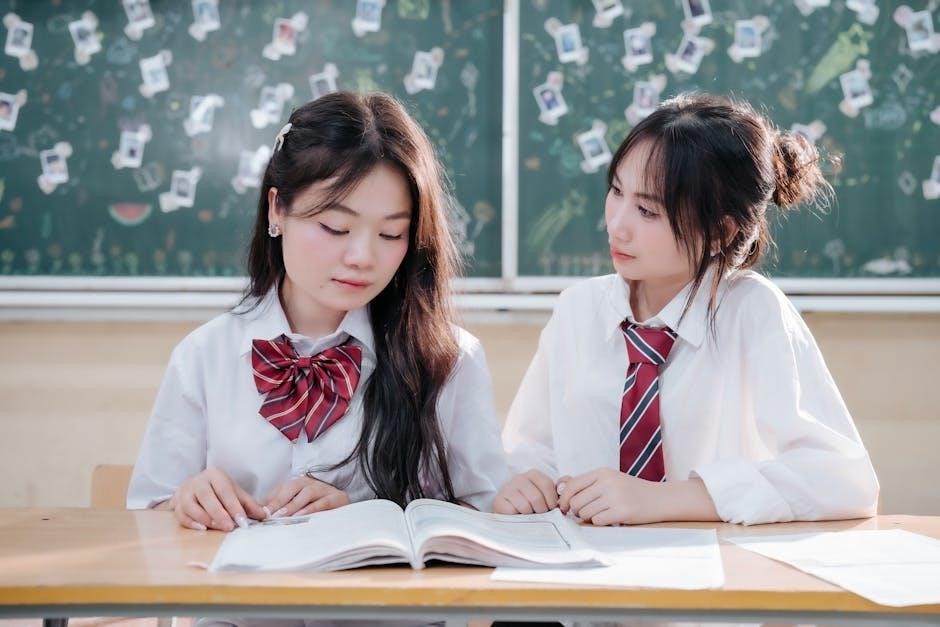The Suzuki Violin School, Volume 1, is a foundational guide for violinists, introducing essential techniques and musical concepts․ Revised editions feature new engravings, additional exercises, and multilingual text, enhancing learning for students and teachers alike․
1․1 Overview of the Suzuki Violin Method
The Suzuki Violin Method, developed by Shinichi Suzuki, is a renowned approach to music education based on the belief that every child can learn․ It emphasizes the importance of a nurturing environment, parental involvement, and early exposure to music․ The method uses a “mother-tongue” approach, where students learn music through immersion and repetition, similar to language acquisition․ The revised editions of Suzuki Book 1 include new engravings, additional exercises, and multilingual text, enhancing accessibility for global learners․ The method focuses on fostering technical skill, musicality, and character development, with repertoire pieces like Twinkle, Twinkle, Little Star and Lightly Row introduced systematically․ Accompanying CDs and online resources provide valuable practice tools, making it a comprehensive system for violin education․
1․2 Importance of Suzuki Book 1 in Violin Education
Suzuki Book 1 is a cornerstone of violin education, providing a structured and nurturing approach for beginners․ It introduces fundamental techniques and musical concepts, such as bowings and fingerings, through a carefully curated repertoire․ The revised edition enhances learning with new engravings, additional exercises, and multilingual support, making it accessible to a global audience․ Students develop essential skills like tone production, intonation, and rhythm through pieces like Twinkle, Twinkle, Little Star and Lightly Row․ The book also fosters confidence and motivation, as students progress to performance tempos and experience the joy of playing․ Its systematic approach ensures a solid foundation for advanced studies, while its emphasis on character development aligns with the Suzuki Method’s holistic philosophy․

Key Features of the Revised Edition
The revised edition features new engravings, expanded content with additional exercises, and multilingual support․ It includes a CD with performances by Hilary Hahn for reference․
2․1 New Engravings and Formatting
The revised edition of Suzuki Violin School, Volume 1, boasts new engravings and a larger 9×12 format, enhancing readability․ The updated bowings and fingerings provide clarity for students and teachers․ These improvements ensure precise technique and musical expression, aligning with the Suzuki Method’s emphasis on proper violin playing․ The fresh layout and detailed markings make practice and performance more accessible․ This formatting reflects the method’s commitment to fostering talent through clear guidance and structured learning․ The engravings are visually appealing and user-friendly, making the book an essential resource for violin education․
2;2 Additional Exercises and Editorial Insights
The revised Suzuki Violin School, Volume 1, includes 16 additional pages of exercises and insights, enriching the learning experience․ These exercises, some by Shinichi Suzuki, focus on refining technique and musicality․ Teachers benefit from editorial notes offering practical suggestions for instruction․ The expanded content supports students in mastering foundational skills, ensuring a solid musical base․ This enhancement aligns with the Suzuki Method’s goal of nurturing talent through comprehensive education․ The added material provides depth and variety, making the book a valuable tool for both students and educators․ These improvements highlight the method’s dedication to fostering excellence in violin playing through structured and insightful learning․
2․3 Multilingual Text Support
The revised Suzuki Violin School, Volume 1, now includes multilingual text support, offering instructions in English, French, German, and Spanish․ This feature ensures accessibility for students and teachers worldwide, breaking language barriers and fostering a unified learning experience․ The inclusion of multiple languages reflects the global reach of the Suzuki Method, allowing diverse communities to benefit from its principles․ This enhancement supports the method’s mission of making high-quality music education available to all, regardless of linguistic background․ The multilingual text aids in understanding and communication, enabling teachers to guide students more effectively․ This addition underscores the method’s adaptability and commitment to inclusivity in music education․

Musical Pieces and Exercises
Suzuki Book 1 introduces foundational pieces like Twinkle, Twinkle, Little Star Variations and Lightly Row, designed to gradually develop technique and musicality in young violinists․
3․1 Twinkle, Twinkle, Little Star Variations
Twinkle, Twinkle, Little Star Variations is a cornerstone of Suzuki Book 1, introducing foundational techniques and musical concepts․ These variations gradually build intonation, rhythm, and bow control, offering a playful yet structured approach to violin learning․ The piece begins with simple melodies and progresses to more complex variations, ensuring a smooth transition for beginners․ Its familiarity and repetitive structure make it engaging for young students, fostering confidence and musicality․ The inclusion of performance tempo recordings further aids in practice and performance preparation, helping students achieve a polished sound early in their musical journey․ This piece is integral to the Suzuki Method, laying the groundwork for future technical and artistic development․
3․2 Lightly Row and Other Folk Songs
Lightly Row and other folk songs in Suzuki Book 1 are essential for developing musicality and technical skills․ These pieces, including Song of the Wind, Go Tell Aunt Rhody, O Come, Little Children, May Song, and Long, Long Ago, introduce students to diverse musical styles and rhythms․ Lightly Row, with its lively tempo, enhances bow control and intonation, while the other folk songs foster a deeper connection to cultural heritage․ These selections are arranged to promote gradual technical progression, ensuring students build confidence and artistry․ The inclusion of these pieces in performance tempo recordings allows for effective practice and performance preparation, making learning both enjoyable and enriching․ These songs are a cornerstone of the Suzuki curriculum, nurturing young musicians’ growth and appreciation for music․

Benefits for Students and Teachers
The revised Suzuki Book 1 enhances skill development and technical proficiency for students while offering teachers valuable insights and methodological approaches to foster effective learning and musical growth․
4․1 Skill Development and Technical Proficiency
Suzuki Book 1 is designed to systematically develop foundational violin skills, starting with proper posture, bow control, and finger placement․ The revised edition includes additional exercises to refine intonation, rhythm, and tone production․ Pieces like Twinkle, Twinkle, Little Star Variations and Lightly Row introduce students to basic techniques, such as open strings, fingerings, and simple bow strokes․ These exercises build technical proficiency while fostering musicality․ The method emphasizes gradual progression, allowing students to master each skill before advancing․ The accompanying CD provides performance tempos, helping students develop timing and phrasing․ This structured approach ensures a strong technical foundation, preparing students for more complex repertoire in later volumes․
4․2 Teaching Insights and Methodological Approaches
The Suzuki Method emphasizes a nurturing, child-centered approach, believing every child can learn․ Teachers are encouraged to create a supportive environment, fostering motivation and creativity․ The revised Book 1 offers insights and suggestions, helping teachers guide students effectively․ New engravings and formatting enhance clarity, while additional exercises provide flexibility․ The inclusion of multilingual text supports diverse learning environments․ Teachers are advised to use demonstration, repetition, and positive reinforcement to build confidence․ The method advocates for parental involvement, creating a partnership between teacher, parent, and student․ This holistic approach ensures comprehensive development, blending technical skill with musical expression․ By adhering to these principles, educators can unlock each student’s potential, fostering a lifelong love for music and learning․

Resources and Accessories
The revised edition includes an accompanying CD with performance tempos and practice tracks․ Additional online resources offer practice materials and exercises, supporting both students and teachers effectively․
5․1 Accompanying CD Recordings
The accompanying CD for Suzuki Violin School, Volume 1, features professional recordings of all pieces, including performance and practice tempos․ These recordings, performed by renowned violinists like Hilary Hahn, provide students with clear models to emulate, aiding in developing tone and phrasing․ The CDs include both piano accompaniments and solo violin tracks, allowing students to practice with or without accompaniment․ Additionally, the recordings are available for download, offering convenience for modern learners․ The CDs are integral to the Suzuki Method, as they help students internalize the music and build confidence in their performance abilities․ They are a valuable resource for both home practice and in-studio lessons․
5․2 Online Resources and Practice Materials
Supplementing the Suzuki Violin School, Volume 1, are extensive online resources and practice materials․ These include downloadable MP3 recordings, video tutorials, and interactive apps designed to enhance learning․ Students can access playlists with performance and practice tempos, enabling them to play along and refine their skills․ Additionally, online platforms offer sheet music, practice guides, and instructional videos featuring renowned violinists․ These digital tools provide flexibility and accessibility, allowing learners to practice anywhere and at their own pace․ Teachers also benefit from these resources, as they can incorporate them into lessons for a more engaging and comprehensive education․ The integration of technology with traditional methods ensures a well-rounded musical experience for students of all levels․

The Importance of the Suzuki Method
The Suzuki Method emphasizes that every child can learn, fostering musical ability through early exposure and parental involvement․ It highlights the role of environment and individualized instruction, promoting talent development and nurturing a love for music from an early age․

6․1 Philosophy and Core Principles
The Suzuki Method’s philosophy centers on the belief that every child possesses innate talent, which can be nurtured through an enriching environment․ Shinichi Suzuki emphasized that music education should foster not only technical skill but also character development and a deep appreciation for music․ Central principles include early beginning, parental involvement, and individualized instruction, ensuring a personalized learning experience․ The method also incorporates the concept of the “Mother Tongue Approach,” where learning music mirrors language acquisition, with repetition and immersion playing key roles․ This holistic approach aims to create well-rounded musicians who value discipline, creativity, and the joy of music-making․ By focusing on these principles, the Suzuki Method has become a cornerstone of music education worldwide․